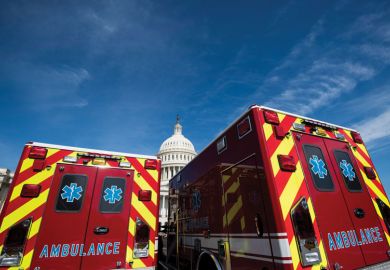Even amid a renewed national commitment to racial justice, old partisan stalemates are hindering US colleges seeking campus reopening plans that balance economic needs with health risks.
Overall, most US universities are promising open campuses this fall, frightened by visions of financial disaster with online-only formats. Yet fear among students and their families still seems stronger.
“Large percentages of colleges” expect shrinking enrolment, even after many extended acceptance deadlines to June, said David Hawkins, executive director for educational content and policy at the National Association for College Admission Counselling.
Congress, however, appears to have reached the limit of its helpfulness, with any expansion of an initial $14 billion (£11 billion) federal pandemic aid package looking unlikely for colleges that are finding it woefully insufficient.
Instead, lawmakers are settling into corners where Republicans are pushing liability waivers and aggressive campus reopenings, and Democrats are warning of harm to low-income and minority students and workers.
Senator Lamar Alexander of Tennessee, convening the Senate’s education committee, suggested college presidents make better off-hours use of their facilities. “Colleges are notorious wasters of space,” Mr Alexander, the panel’s chairman told a hearing meant to study safe reopenings.
“The risk is not zero of health effects,” added Senator Bill Cassidy, a Republican of Louisiana and professional gastroenterologist. “But what we do know is that if you miss out on critical years of education, it’s an absolute 100 per cent risk that your future economic prospects are minimised.”
Democrats, in turn, cited the week-long national turmoil over the killing by Minneapolis police of George Floyd as yet another warning to help the most vulnerable.
Senator Elizabeth Warren, a Democrat of Massachusetts and former 2020 presidential contender, blasted Republican-backed calls by the broad US university community for Congress to pass new legal liability protections before they reopen their campuses.
More than 30 groups representing students, consumers and workers joined her in rejecting the idea. Writing to the committee, the groups said legal liability would encourage the example of Liberty University, the conservative religious institution that invited its students back to campus in late March.
Several Liberty students were reported to have contracted the virus as a result. Liberty denied that, saying it had no cases.
Either way, only a fraction of Liberty’s 15,000 on-campus students returned, almost half of those left within days and the wider academic community still doesn’t know what level of testing capability is safe.
Georges Benjamin, executive director of the American Public Health Association, told lawmakers the US is conducting about 400,000 tests a day, but needs at least 500,000 and possibly far more to ensure safe public gatherings.
Some campuses are countering with heavy investment in protections. Mitch Daniels, president of Purdue University and a former Republican governor of Indiana, told senators his campus has a reopening plan costing “tens of millions of dollars”.
It includes removing 1,000 dormitory beds and converting many rooms into single occupancy, plus buying at least a mile of Plexiglas for barriers between faculty and students.
Polling nevertheless has shown students and their families are sceptical about safety, leaving colleges to wonder what they will do this fall.
Stefanie Niles, the vice-president for enrolment at Ohio Wesleyan University, told Times Higher Education that her campus is currently exceeding its fall enrolment targets and that many of her counterparts around the country are in similar positions, but she also admitted “a much greater chance for fluctuation this summer”.
And Moody’s Investors Service, in a new report, said that even if US colleges maintain fall enrolment numbers, they will still see revenue declines for the coming academic year of between 5 per cent and 13 per cent. It explained that more students and families caught by the economic downturn will seek lower-cost options such as community colleges, pushing down the rates colleges can charge.
Conditions are even worse for the poorest students, according to a new analysis from experts at the University of Pennsylvania and the Council for Opportunity in Education. Among families in the lowest 20 per cent by income, their study found, the net price of college has jumped from 56 per cent of family income in 2008 to 94 per cent in 2016.
Logan Hampton, president of the historically black Lane College, emphasised such realities to the senators in pleading for expanded federal aid. “The majority of my students are black Americans,” Dr Hampton said. “And black Americans are disproportionately impacted by Covid-19 and racism that continues to impact our nation.”
Register to continue
Why register?
- Registration is free and only takes a moment
- Once registered, you can read 3 articles a month
- Sign up for our newsletter
Subscribe
Or subscribe for unlimited access to:
- Unlimited access to news, views, insights & reviews
- Digital editions
- Digital access to THE’s university and college rankings analysis
Already registered or a current subscriber?







